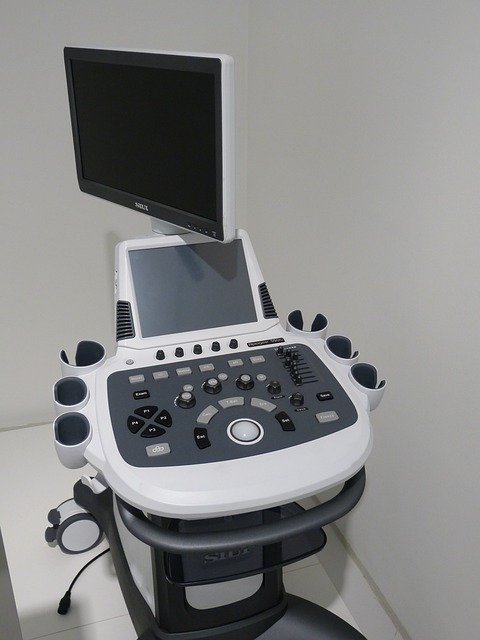Peranan Ultrasonografi Toraks dalam Menegakkan Diagnosis Beberapa Kelainan pada Paru
[The Role of Ultrasound in Diagnosing Pulmonary Diseases]

Downloads
Ultrasound is useful in the diagnosis of cases in the field of lung disease, such as pleural effusion, pneumothorax, consolidation, atelectasis, pulmonary edema, and others. The advantages of thoracic ultrasound is a low cost, radiation is small, easy to carry, short examination time and has a dynamic aspect that can be seen at the time of examination. Thoracic ultrasound is an inexpensive tool and can be used to assist in intervention, especially in cases of peripheral lung, pleura and chest wall diseases, such as thoracocentesis, chest tube installation and aspiration lung abscess. Ultrasound can also replace aspiration and biopsy with CT-scan guidance in cases involving the pleura, chest wall, and lung tumors that invade the pleura and chest wall. With the ultrasound portable and compact form, in the future is possible if the ultrasound will be a routine part of the examination as well as a stethoscope. However, ultrasound also has limitations which in patients with subcutaneous emphysema, peripheral edema and obesity, lung ultrasound is hard to do. Ultrasound examination is also highly dependent on the experience and ability of the ultrasound operator.
Koegelenberg CF, Bollinger CT, Diacon A. Pleural Ultrasound. In Light RW, Lee YG, editors. Textbook of pleural diseases. 2nd ed. London: Hodder Arnold; 2008. p. 271-284.
Mayo PH, Doelken P. Pleural Ultrasonography. Clin Chest Med. 2006; 27: p. 215-227.
Felson B. Principle of chest roentgenology. 3rd ed. Goodman LR, editor. Philadelphia: Saunders Elsevier; 2007.
Nafae R, Eman SR, Mohamad NA, El-Ghamry R, Ragheb AS. Adjuvant role of lung Ultrasound in the diagnosis of pneumonia in intensive care unit-patients. [Online].; 2013 [cited 2013 September 5. Available from: http://dx.doi.org/10.1016/j.ejcdt.2013.04.007.
Sartori S, Tombesi P, Trevisani L, Nielsen I, Tassinari D, Abbasciano V. Accuracy of transthoracic sonography in detection of pneumothorax after sonographically guided lung biopsy: prospective comparison with chest radiography. AJR. 2007; 188: p. 37-41.
Soldati G, Testa A, Pignataro G, Sala ML, Silveri NG. Diagnostic accuracy of lung ultrasonography in the emergency department. CHEST. 2008; 133(1): p. 204-11.
Vollmer I, Gayete A. Chest ultrasonography. Arc Bronconeumol. 2010; 46(1): p. 27-34.
Hakimisefat B, Mayo PH. Lung ultrasonography. Crit Care Med. 2010; 3: p. 21-25.
Bollinger CT, Herth FJF, Mayo PH, Beamis JF. Toracic ultrasound overview. Prog Respir Res. 2009; 37: p. 11-20.
Rempell J, Noble V. Using lung ultrasound to defferentiate patients in acute dyspnea in the pre hospital emergency setting. Critical Care. 2011; 15: p. 161.
Havelock T, Teoh R, Laws D, Gleeson F. Pleural procedures and thoracic ultrasound. Thorax. 2010; 65: p. i61-i76.
Cibinel GA, Casoli G, Elia F, Padoan M, Pivetta E, Lupia E, et al. Diagnostic accuracy and reproducibility of pleural and lung ultrasound in discriminating cardiogenic causes of acutedyspnea in the Emergency Department. Intern Emerg Med. 2012; 7: p. 65-70.
Manson WC, Bonz JW, Carmody K, Osborne M, Moore CL. Identification of sonographic B-lines with linier transducerpredict elevated B-type natriuretic peptide level. West J of Emerg Med. 2011; 12(1): p. 102-6.
Grimberg A, Shigueoka DC, Atallah AN, Azjen S, Lared W. Diagnostic accuracy of sonography of pleural effusion: systematic review. Sao Paulo Med J. 2010; 128(2): p. 90-5.
Youk JH, Kim EK, Kim MJ, Oh kk. Imaging finding of chest wall lesions on breast sonography. J Ultrasound Med. 2008; 27: p. 125-38.
Knudtson JL, Dort JM, Helmer SD, Smith RS. Surgeon-perform ultrasound for pneumothorax in the trauma suite. J Trauma. 2004; 56(3): p. 527-30.
Doelken P, Mayo PH. Ultrasound-Guided Transthoracic Procedures. In Levitov A, Mayo PH, Sonim AD, editors. Critical Care Ultrasonography. 1st ed. Chicago: McGraw-Hill Education; 2009. p. 311-21.
Wilkerson RG, Stone MB. Sensitivity of bedside ultrasound and supine anteroposterior chest radiographs for the identification of pneumothorax after blunt trauma. ACAD emerg Med. 2010; 17(1): p. 11-9.
Xirouchaki N, Geogopoulos D. The use of lung ultrasound: abrief review for critical care physicians and pneumologist. PNEUMON. 2007; 20(2): p. 134-41.
Kopman DF. Ultrasound Guided Thoracosintesis. CHEST. 2006; 129(6): p. 1709-14.
Chandra S, Narasimhan M. Pleural Ultrasonography. Crit Care Med J. 2010; 3: p. 26-32.
Gillman LM, Kirkpatrick AW. Portable bedside ultrasound: the visual stethoscope of the 21st century. Scandinavian J Trauma Res Emerg Med. 2012; 20(18): p. 1-8.
Nalos M, Kot M, McLean AS, Lichtenstein D. Bedside lung ultrasound in the care of the critically ill. Curr Res Med Rev. 2010; 6(4): p. 271-8.
Diacon AH, Theron J, Bolliger CT. Transthoracic Ultrasound for the Pulmonologist. Curr Opin Pulm Med. 2005; 11: p. 307-12.
Liteplo AS, Marill KA, Villen T, Miller RM, Murray AF, Croft PE, et al. Emergency thoracic Ultrasound in the defferentiation of the etiology of shortness of breath (ETUDES): Sonographyc B-lines and Nterminal pro-brain-type natriuretic peptide in diagnosing congestif heart failure. ACAD Emerg Med. 2009; 16(3): p. 201-10.
Bauhemad B, Zhang M, Lu Q, Rouby JJ. Clinical review: Bedside lung ultrasound in critical care practice. Crit Care. 2007; 11(1): p. 1-9.
Copyright (c) 2015 Erwin Winaya, Winariani Koesoemoprodjo

This work is licensed under a Creative Commons Attribution-ShareAlike 4.0 International License.
1. The journal allows the author to hold the copyright of the article without restrictions.
2. The journal allows the author(s) to retain publishing rights without restrictions.
3. The legal formal aspect of journal publication accessibility refers to Creative Commons Attribution Share-Alike (CC BY-SA).
4. The Creative Commons Attribution Share-Alike (CC BY-SA) license allows re-distribution and re-use of a licensed work on the conditions that the creator is appropriately credited and that any derivative work is made available under "the same, similar or a compatible license”. Other than the conditions mentioned above, the editorial board is not responsible for copyright violation.





































 JR (
JR (